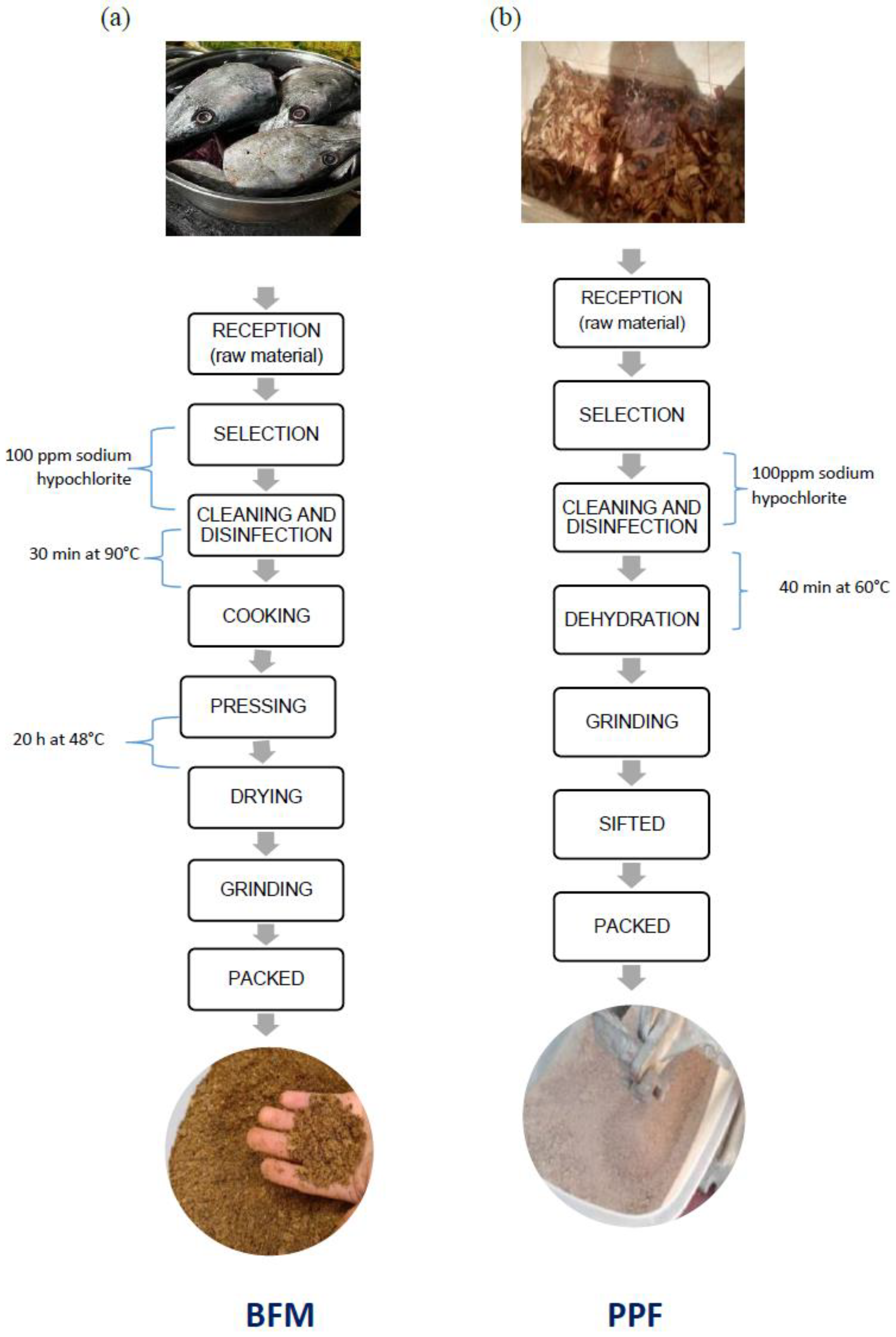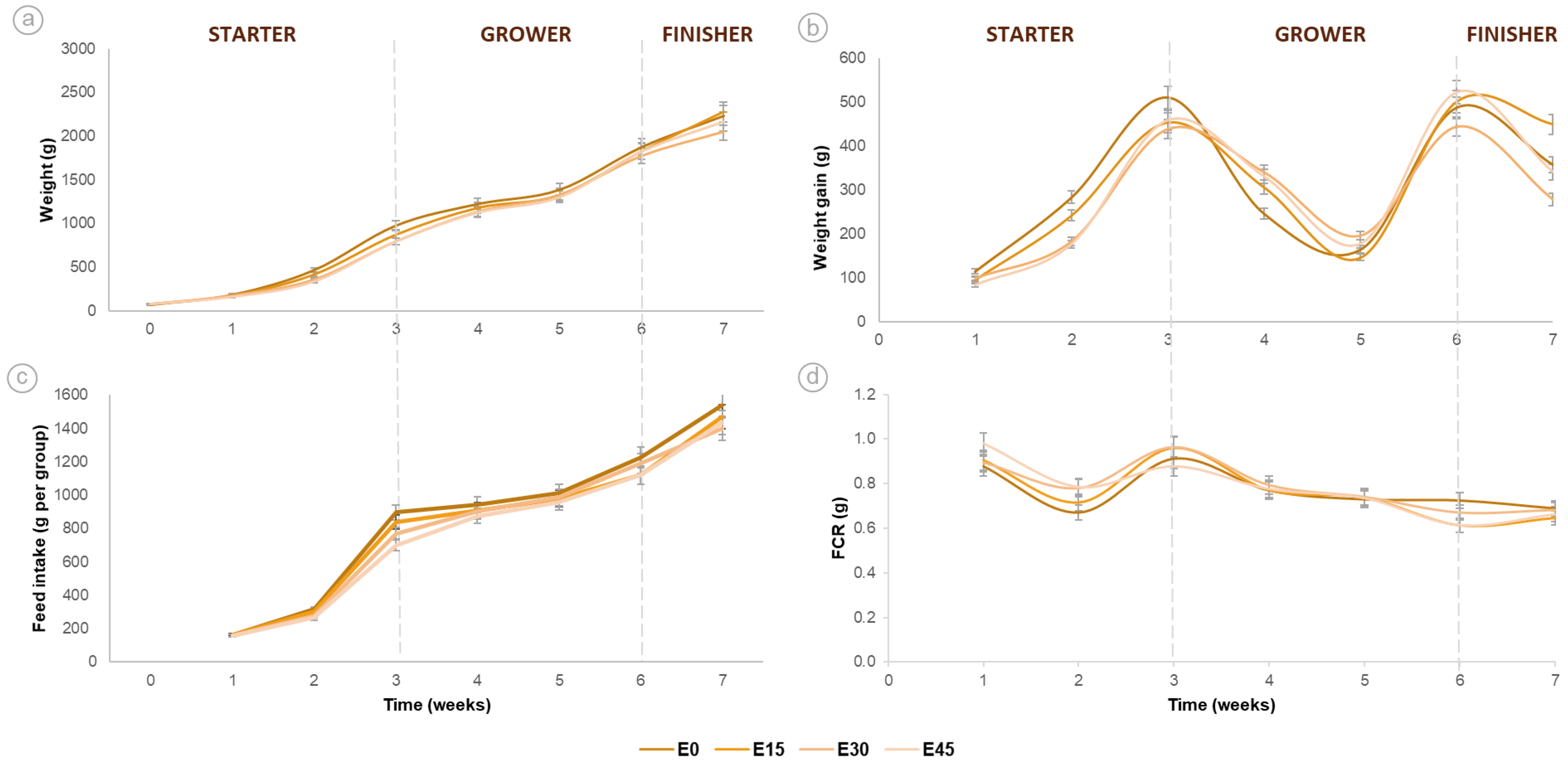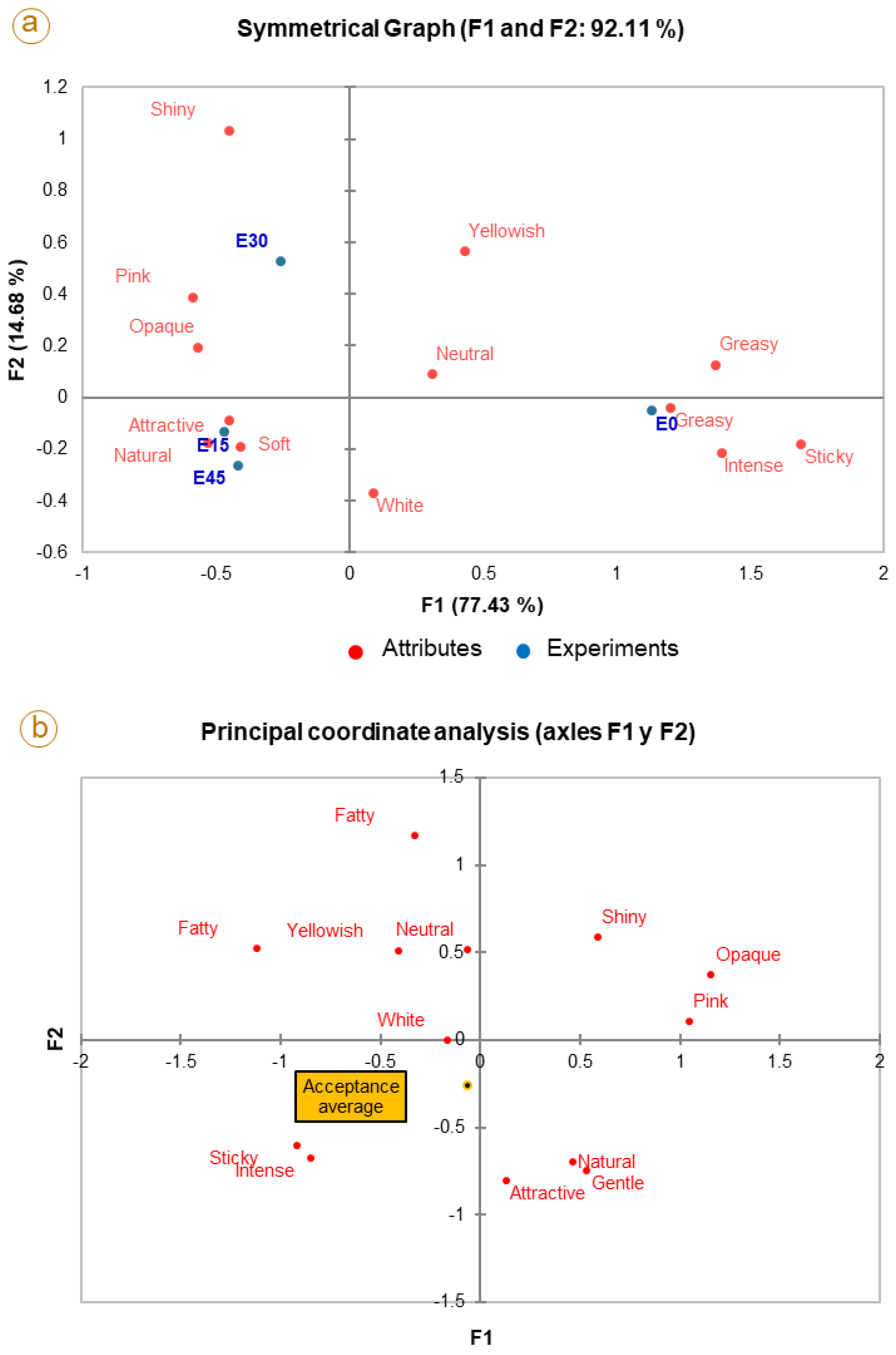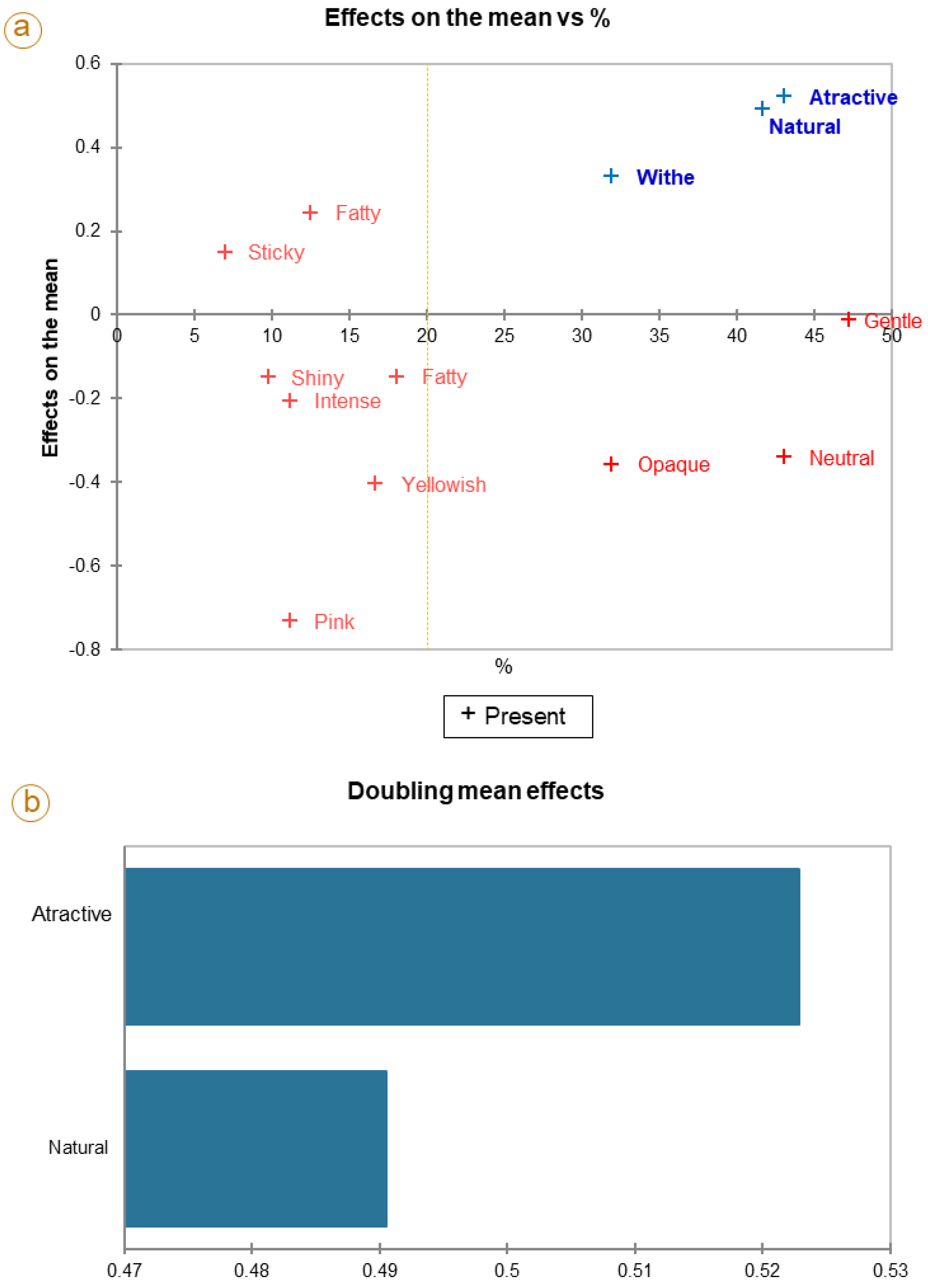Valorization of Food By-Products: Formulation and Evaluation of a Feed Complement for Broiler Chickens Based on Bonito Fish Meal and Única Potato Peel Flour
Abstract
1. Introduction
2. Materials and Methods
2.1. Production and Nutritional Characterization of Bonito Fish Meal (BFM) and Potato Peel Flour (PPF)
2.2. Formulation of Balanced Diets
2.3. Nutritional Evaluation of Feed-Complemented Diets for Broiler Chicken Growth
2.4. Sensory Analysis
2.5. Statistical Analysis
3. Results and Discussion
3.1. Nutritional Characteristics of Bonito Fish Meal (BFM) and Potato Peel Flour (PPF)
3.2. Nutritional Evaluation of the Feed Complement and Experimental Diets
3.3. Effect of Feed-Complemented (FC) Inclusion on Broiler Chicken Growth
3.4. Effect of Feed Complement (FC) Inclusion on the Sensory Characteristics of Broiler Chicken Meat
3.4.1. Acceptance Test
3.4.2. CATA
3.5. Broader Implications and Resource Context
4. Conclusions
Supplementary Materials
Author Contributions
Funding
Institutional Review Board Statement
Data Availability Statement
Conflicts of Interest
References
- World Health Organization. Food Production Grew by 12.2% in April 2020. National Institute of Statistics and Informatics (INEI). 2020. Available online: https://iris.who.int/bitstream/handle/10665/332070/9789240005105-eng.pdf (accessed on 30 July 2025).
- Basso, N.; Brkic, M.; Moreno, C.; Pouiller, P.; Romero, A. Let’s value food, avoid losses and waste. Diaeta 2016, 34, 25–32. [Google Scholar]
- Morales, M.; Gabriela, M. Technical Analysis of Andean Tubers (Chinese Potato, Sweet Potato, White Carrot) to Process Functional Products in Tungurahua Province; Technical University of Ambato: Ambato, Ecuador, 2021; Available online: https://repositorio.uta.edu.ec/handle/123456789/33638 (accessed on 29 April 2025).
- Giuffra, B. The palate industry and the boom of Peruvian gastronomy. Cont. J. 2016, 1, 7. [Google Scholar]
- APA-AVICULTURA PERÚ. Boletín APA Informa; Asociación Peruana de Avicultura (APA): Lima, Peru, 2022. [Google Scholar]
- Abad Bazán, J.C. Rendimiento Productivo y Económico del Engorde Intensivo de Pollos Broiler de las Líneas Ross y Cobb en Huancayo. Tesis de Pregrado, Universidad Nacional del Centro del Perú, Huancayo, Peru, 2008. Available online: https://repositorio.uncp.edu.pe/handle/20.500.12894/2888 (accessed on 10 April 2025).
- El Khattabi, A.; Handa, S.; El Midaoui, M.; Nassiri, M.; Lemkhanter, S.; Ibijbijen, Y.M. Reutilización de desechos alimentarios en la alimentación de pollos orgánicos. E3S Web Conf. 2021, 234, 00090. [Google Scholar]
- Ramírez, V.M.; Peñuela, L.M.; Pérez, M.R. Organic waste as an alternative for swine feeding. Anim. Sci. Dairy Colomb. 2017, 34, 2. [Google Scholar] [CrossRef]
- Calderón Hernández, R.; Cortés Jaramillo, N.C. Utilization of Organic Waste as Input for Animal Feed Industry ABA. Bachelor‘s Thesis, University of La Salle, Bogotá, Colombia, 2004. Available online: https://hdl.handle.net/20.500.14625/33186 (accessed on 12 April 2025).
- Barrera, L.; Pablo, J. Evaluation of Feed Conversion in Broiler Chickens Using Three Levels of Fishmeal; Polytechnic University of Salesian: Quito, Ecuador, 2016; Available online: https://dspace.ups.edu.ec/handle/123456789/12165 (accessed on 12 April 2025).
- Lúquez-Pérez, L.d.R.; Hleap-Zapata, J.I. Feasibility of using fishmeal from Zapatosa Swamp in broiler feeding. Rev. U.D.C.A Actual. Divulg. Cient. 2020, 23, e1202. [Google Scholar] [CrossRef]
- Garnida, Y.; Rudiansyah, M.; Yasin, G.; Mahmudiono, T.; Kadhim, A.J.; Sharma, S.; Hussein, A.; Shichiyakh, R.A.; Abdelbasset, W.K.; Iswanto, A.H. Investigation of parameters in restaurant food waste for use as poultry rations. Food Sci. Technol. 2022, 42, e118621. Available online: https://www.scielo.br/j/cta/a/wpTjxNBS5rJFkKrkqDQNrQM/ (accessed on 12 April 2025). [CrossRef]
- Valenzuela, C.; Carvallo, F.; Morales, M.S.; Reyes, P. Effect of using dry salmon silage in broiler diets on productive parameters and meat sensory quality. Arch. Med. Vet. 2015, 47, 53–59. [Google Scholar] [CrossRef]
- Dávalos Cuno, L.M. Desarrollo de Nuggets de Bonito (Sarda chiliensis chiliensis) Bajos en Calorías y con la Adición de chía (Salvia hispanica) como Antioxidante. Bachelor’s Thesis, Universidad Nacional de San Agustin de Arequipa, Arequipa, Peru, 2016. [Google Scholar]
- Gutierrez Rosales, R.O.; Espinoza-Trelles, J.A.; Bonierbale, M. UNICA: Peruvian variety for fresh market and fries with tolerance and resistance to adverse climatic conditions. Lat. Am. J. Potatoes 2016, 14, 41–50. [Google Scholar] [CrossRef]
- INEI. Producción de Papa Creció 12,2% en Abril del 2020. Instituto Nacional de Estadística e Informática. 2020. Available online: https://m.inei.gob.pe/prensa/noticias/produccion-de-papa-crecio-122-en-abril-del-2020-12263/ (accessed on 14 April 2025).
- Karim, A.A.; Bhat, R. Fish gelatin: Properties, challenges, and prospects as an alternative to mammalian gelatins. Food Hydrocoll. 2009, 23, 563–576. [Google Scholar] [CrossRef]
- Espinoza, D.A.; Torres, B.D.M.; Vargas, R.D.; Torrescano, G.R.; Sánchez, A. Valorization of potato peel waste as natural additive for use in meat products. Resources 2023, 12, 148. [Google Scholar] [CrossRef]
- AOAC. Official Methods of Analysis of AOAC International, 18th ed.; AOAC International: Rockville, MD, USA, 2005; Available online: https://www.researchgate.net/publication/292783651_AOAC_2005 (accessed on 10 January 2025).
- NRC. Nutrient Requirements of Poultry, 9th ed.; National Academies Press: Washington, DC, USA, 1994. [CrossRef]
- Rostagno, H.S.; Albino, L.F.T.; Hannas, M.I.; Donzele, J.L.; Sakomura, N.K.; Perazzo, F.G.; Saraiva, A.; de Abreu, M.L.T.; Paulo Rodrigues, B.; de Oliveira, R.F.; et al. Tablas Brasileñas para Aves y Cerdos: Composición de Alimentos y Requerimientos Nutricionales, 4th ed.; UFV: Viçosa, Brazil, 2017. [Google Scholar]
- Acosta, R.D. Evaluación Productiva y Económica del uso de tres Niveles de Harina de Papa (Solanum tuberosum) en la Alimentación de Pollos Cobb 500 en Huánuco-2021. Bachelor’s Thesis, Universidad Nacional Hermilio Valdizán, Huánuco, Peru, 2022. [Google Scholar]
- Wu, K.; Wang, F.; Yang, S.; Zhang, C.; Xie, M.; Li, J.; Yin, Y.; Yao, K. Effects of fish bone meal supplementation on growth performance, blood immunity, intestinal morphology, and gut microbiota in laying hens. Poult. Sci. 2025, 104, 103878. [Google Scholar] [CrossRef] [PubMed]
- Majo, V.; Alejandra, K.N. Production of Chemical Ensilage from Fish Waste for Balanced Poultry Feeding in Ilo-Moquegua; César Vallejo University: Moquegua, Peru, 2022; Available online: https://repositorio.ucv.edu.pe/handle/20.500.12692/96315 (accessed on 10 January 2025).
- Meilgaard, M.C.; Carr, B.T.; Civille, G.V. Sensory Evaluation Techniques, 4th ed.; CRC Press: Boca Raton, FL, USA, 2006. [Google Scholar] [CrossRef]
- Ares, G.; Jaeger, S.R. Check-all-that-apply questions: Influence of attribute order on sensory product characterization. Food Qual. Prefer. 2013, 28, 141–153. [Google Scholar] [CrossRef]
- Salvador-Reyes, R.; de Brito, A.D.C.; Sampaio, U.; Moro, T.M.A.; Clerici, M.T.P.S.; Behrens, J. Exploring the perception and sensory acceptance of a Peruvian purple maize breakfast cereal by Brazilian consumers. Sci. Agropecu. 2023, 14, 7–19. [Google Scholar] [CrossRef]
- Cornejo, S.; Hidalgo, H.; Araya, J.; Pokniak, J. Supplementation of commercial laying hen diets with fish oils of different refining levels: Productive effects on the birds and organoleptic quality of the eggs. Arch. Med. Vet. 2008, 40, 45–50. [Google Scholar] [CrossRef]
- Al-Marzooqi, W.; Al-Farsi, M.A.; Kadim, I.T.; Mahgoub, O.; Goddard, J.S. The effect of feeding different levels of sardine fish silage on broiler performance, meat quality and sensory characteristics under closed and open-sided housing systems. Asian-Australas. J. Anim. Sci. 2010, 23, 1614–1625. [Google Scholar] [CrossRef]
- Teigiserova, D.A.; Hamelin, L.; Thomsen, M. Towards transparent valorization of food surplus, waste and loss: Clarifying definitions, food waste hierarchy, and role in the circular economy. Sci. Total Environ. 2020, 706, 136033. [Google Scholar] [CrossRef] [PubMed]
- Makkar, H.P.S.; Tran, G.; Heuzé, V.; Ankers, P. State-of-the-art on use of insects as animal feed. Anim. Feed. Sci. Technol. 2014, 197, 1–33. [Google Scholar] [CrossRef]
- Girotto, F.; Alibardi, L.; Cossu, R. Food waste generation and industrial uses: A review. Waste Manag. 2015, 45, 32–41. [Google Scholar] [CrossRef] [PubMed]




| Experiment | CBF (%) | FC (%) |
|---|---|---|
| E0 | 100 | 0 |
| E15 | 85 | 15 |
| E30 | 70 | 30 |
| E45 | 55 | 45 |
| Characteristics 1 | BFM | PPF |
|---|---|---|
| Energy (Kcal/100 g) | 449.66 ± 8.99 | 341.97 ± 15.73 |
| Carbohydrates (g/100 g) | 3.27 ± 0.05 | 74.08 ± 1.19 |
| Protein (g/100 g) | 50.78 ± 1.02 | 10.76 ± 0.30 |
| Moisture (g/100 g) | 6.08 ± 0.14 | 7.62 ± 0.19 |
| Ash (g/100 g) | 13.93 ± 0.42 | 7.25 ± 0.11 |
| Crude Fiber (g/100 g) | 2.17 ± 0.03 | 6.23 ± 0.06 |
| Fat (g/100 g) | 25.94 ± 0.93 | 0.29 ± 0.01 |
| Composition 1 (g/100 g) | BFM (48%) | PPF (52%) | FC (100%) | CBF (Reference) |
|---|---|---|---|---|
| Carbohydrates (g/100 g) | 1.57 | 38.52 | 40.09 | 50.00 |
| Protein (g/100 g) | 24.37 | 5.6. | 29.97 | 30.00 |
| Moisture (g/100 g) | 2.92 | 3.96 | 6.88 | 13.00 |
| Ash (g/100 g) | 6.69 | 3.77 | 10.46 | 9.00 |
| Crude fiber (g/100 g) | 1.04 | 3.24 | 4.28 | 4.00 |
| Fat (g/100 g) | 12.45 | 0.15 | 12.6. | 3.00 |
| Experiments | Aroma | Color | Taste | Appearance |
|---|---|---|---|---|
| E0 | 7.00 ± 0.69 | 7.11 ± 0.76 | 7.28 ± 0.67 | 7.33 ± 0.84 |
| E15 | 7.44 ± 1.10 | 7.94 ± 0.73 | 8.06 ± 0.73 | 7.17 ± 1.38 |
| E30 | 6.94 ± 1.00 | 7.06 ± 1.30 | 6.89 ± 1.18 | 6.83 ± 0.86 |
| E45 | 7.33 ± 1.24 | 7.56 ± 0.98 | 7.56 ± 0.98 | 7.28 ± 1.23 |
| Attribute | p-Value | E0 | E15 | E30 | E45 |
|---|---|---|---|---|---|
| Appearance | |||||
| Shiny | 0.577 | 0.333 (a) | 0.167 (a) | 0.167 (a) | 0.167 (a) |
| Greasy | <0.0001 | 0.611 (b) | 0 (a) | 0.111 (a) | 0 (a) |
| Opaque | 0.012 | 0 (a) | 0.444 (b) | 0.444 (b) | 0.389 (ab) |
| Attractive | 0.009 | 0.111 (a) | 0.611 (b) | 0.389 (ab) | 0.611 (b) |
| Color | |||||
| Pale | 0.245 | 0 (a) | 0.167 (a) | 0.222 (a) | 0.167 (a) |
| Intense | 0.001 | 0.389 (b) | 0.056 (a) | 0 (a) | 0 (a) |
| Yellowish | 0.094 | 0.278 (a) | 0.056 (a) | 0.278 (a) | 0.056 (a) |
| Pink | 0.029 | 0 (a) | 0.278 (a) | 0.167 (a) | 0 (a) |
| Natural | 0.002 | 0.056 (a) | 0.611 (b) | 0.333 (ab) | 0.667 (b) |
| White | 0.040 | 0.389 (ab) | 0.222 (ab) | 0.111 (a) | 0.556 (b) |
| Bright | 0.014 | 0 (a) | 0 (a) | 0.278 (b) | 0.111 (ab) |
| Taste | |||||
| Neutral | 0.078 | 0.667 (a) | 0.389 (a) | 0.389 (a) | 0.278 (a) |
| Fishy | 0.112 | 0.167 (a) | 0.056 (a) | 0 (a) | 0 (a) |
| Sour | 0.300 | 0.111 (a) | 0.056 (a) | 0 (a) | 0 (a) |
| Bitter | 0.112 | 0 (a) | 0 (a) | 0.111 (a) | 0 (a) |
| Acidic | 0.392 | 0.056 (a) | 0 (a) | 0 (a) | 0 (a) |
| Salty | 0.881 | 0.056 (a) | 0.056 (a) | 0.111 (a) | 0.111 (a) |
| Spoiled | 1.000 | 0 (a) | 0 (a) | 0 (a) | 0 (a) |
| Savory | 0.267 | 0.389 (a) | 0.389 (a) | 0.389 (a) | 0.667 (a) |
| Aroma | |||||
| Corn-like | 0.572 | 0 (a) | 0.056 (a) | 0 (a) | 0.056 (a) |
| Odorless | 0.511 | 0.111 (a) | 0.222 (a) | 0.167 (a) | 0.056 (a) |
| Natural aroma | 0.365 | 0.778 (a) | 0.722 (a) | 0.778 (a) | 0.944 (a) |
| Fishy aroma | 0.522 | 0.111 (a) | 0.111 (a) | 0.111 (a) | 0 (a) |
| Corn aroma | 0.392 | 0 (a) | 0.056 (a) | 0 (a) | 0 (a) |
| Spoiled aroma | 0.392 | 0 (a) | 0.056 (a) | 0 (a) | 0 (a) |
| Texture | |||||
| Soft | 0.002 | 0.167 (a) | 0.722 (b) | 0.333 (ab) | 0.667 (b) |
| Hard | 0.152 | 0.333 (a) | 0.278 (a) | 0.611 (a) | 0.333 (a) |
| Pasty | 0.392 | 0 (a) | 0 (a) | 0.056 (a) | 0 (a) |
| Sticky | 0.002 | 0.278 (b) | 0 (a) | 0 (a) | 0 (a) |
| Greasy texture | 0.002 | 0.389 (b) | 0 (a) | 0.056 (a) | 0.056 (a) |
Disclaimer/Publisher’s Note: The statements, opinions and data contained in all publications are solely those of the individual author(s) and contributor(s) and not of MDPI and/or the editor(s). MDPI and/or the editor(s) disclaim responsibility for any injury to people or property resulting from any ideas, methods, instructions or products referred to in the content. |
© 2025 by the authors. Licensee MDPI, Basel, Switzerland. This article is an open access article distributed under the terms and conditions of the Creative Commons Attribution (CC BY) license (https://creativecommons.org/licenses/by/4.0/).
Share and Cite
Espinoza Davila, A.M.; Salvador-Reyes, R. Valorization of Food By-Products: Formulation and Evaluation of a Feed Complement for Broiler Chickens Based on Bonito Fish Meal and Única Potato Peel Flour. Resources 2025, 14, 125. https://doi.org/10.3390/resources14080125
Espinoza Davila AM, Salvador-Reyes R. Valorization of Food By-Products: Formulation and Evaluation of a Feed Complement for Broiler Chickens Based on Bonito Fish Meal and Única Potato Peel Flour. Resources. 2025; 14(8):125. https://doi.org/10.3390/resources14080125
Chicago/Turabian StyleEspinoza Davila, Ashley Marianella, and Rebeca Salvador-Reyes. 2025. "Valorization of Food By-Products: Formulation and Evaluation of a Feed Complement for Broiler Chickens Based on Bonito Fish Meal and Única Potato Peel Flour" Resources 14, no. 8: 125. https://doi.org/10.3390/resources14080125
APA StyleEspinoza Davila, A. M., & Salvador-Reyes, R. (2025). Valorization of Food By-Products: Formulation and Evaluation of a Feed Complement for Broiler Chickens Based on Bonito Fish Meal and Única Potato Peel Flour. Resources, 14(8), 125. https://doi.org/10.3390/resources14080125






